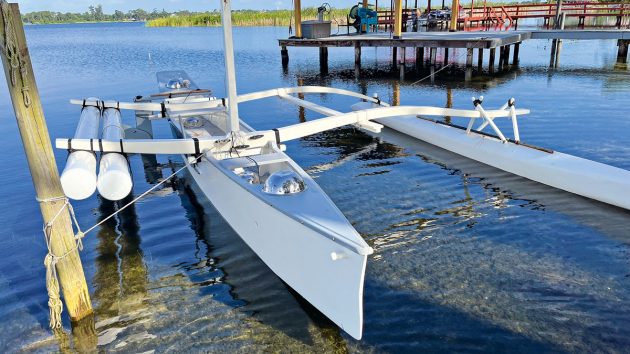Roger Nadin on traditional proa design that’s enjoying a kit-boat revival
Back when Captain Cook ‘discovered’ the South Pacific, local people were using what, to Western eyes, were unusual sailing boats.
These had twin hulls but with one hull shorter than the other.
They couldn’t be sailed into the wind and would not tack through the wind. Instead, the asymmetrical main hull could be sailed in either direction in a move known as shunting.
The attachment of the single crab-claw sail (the tack) to the hull could be moved from one end to the other.
This boat, known as a proa, is sailed so that one of the outriggers is always to windward.

Proa design: T2 proa under sail. Credit: Peter Richardson
Originally developed from a single-hull dugout canoe, the proa was changed to a fast, stable sailing platform with the addition of a single counterbalancing outrigger known as an ama.
The main, longer hull is known as a waka. From small, paddled workboats, proas grew to become stable ocean-crossing sailing craft that were key to the distribution of populations in the Austronesian and Polynesian areas.
History is filled with magnificent stories of great ocean voyages using proas and these continue in one form or another to this day.
With the digital age new proa-based ideas have come from France, the US, Poland and even the UK where proa plans can be found among the multihulls from James Wharram’s drawing board.
Proa design pro and cons
So, what are the advantages of a proa boat?
It’s quick and cheap to build, fast and stable, lightweight, and easily transportable; even boats up to about 18ft can be carried on a roofrack.
Its shoal draught provides access to waters other boats can’t reach and once assembled, the proa provides a comfortable, stable platform on which a standard tent can be erected.
It’s an ideal craft for ‘camp cruising’.
An additional quirk of the design is that it doesn’t have a rudder.
Instead, a steering paddle is used to power the boat when the sail is not in use. If there’s one negative about proas, it’s that they’re not very manoeuvrable.
A similar craft that actually tacks is known as a tacking outrigger canoe, and that would be a better option if sailing in enclosed waterways.
Continues below…
A modern take on the traditional proa boat
Ali Wood finds out more about visionary proa boat designer, Rob Denney
Keel types and how they affect performance
Peter Poland looks at the history of keel design and how the different types affect performance
Sail boat rigs: the pros and cons of each popular design
Peter Poland looks at the history of popular rig designs and how the different types affect boat performance
Freestanding masts: Why more cruisers should go wireless
You see a yacht with a mast, or masts held up with no rigging and think: ‘What’s going on? Why…
How do you get hold of a proa? Some yards will take commissions for proas up to around 36ft, though most modern proas fall into the smaller (16 -25ft) range and are self-built – either from plans or a kit of pre-cut parts.
A recent build here in the UK is a T2 from the New Zealand-based designer, Gary Dierking.
This strip-plank boat was commissioned by its owner to be built at The Boat Building Academy in Lyme Regis.
The owner took the opportunity to also sign up for a boatbuilding course. So – a new boat and a new skill all in one go!
There’s a very active group of proa sailors and builders in Poland.
These proa fans sail the Baltic coast and the big lakes of Poland and produce plans plus kits for boats up to 23ft.
So if you’re looking to keep the costs down and want a fast, easily transportable boat, the proa or outrigger canoe could be the boat for you.
More info on proa designs
For proa design plans and kits visit:
- pjoa.eu
- fyneboatkits.co.uk
- duckworks.com
- clcboats.com
- Plans only from:
selway-fisher.com - Read a journal by designer Michael Schacht at proafile.com
Courses in wooden boatbuilding:
Enjoyed reading this article? 
A subscription to Practical Boat Owner magazine costs around 40% less than the cover price.
Print and digital editions are available through Magazines Direct – where you can also find the latest deals.
PBO is packed with information to help you get the most from boat ownership – whether sail or power.
-
-
-
- Take your DIY skills to the next level with trusted advice on boat maintenance and repairs
- Impartial in-depth gear reviews
- Practical cruising tips for making the most of your time afloat
-
-








